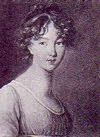
Ever since I first read Post Captain in the very early 1990s, I have wanted to make the Garment (TG). As a reproduction knitter, I study a garment and try to duplicate gauge/tension and materials, using, by necessity, modern yarns unless the project calls for handspun. I knew that a life size version would take a great deal of wool, far more than I could spin or commission to have spun to my specifications. Commercially produced yarns looked far too modern and slick or were too thick or too thin. Most garments I have studied from the late 18th/early 19th centuries have a vary fine gauge/tension, obviously knit on the thin needles we see in 18th/19th century paintings and museum or historical society collections. Would, however, TG have been so finely knit? The texture would have to be sturdy as it was meant to be an outer not an under garment. Since stockings from this era range from very fine to coarsely knit as are some surviving caps, I decided to look for something which would produce a denser knit that would also hold its shape over time.
Quantity was also a consideration. Much as I would have liked to knit TG on 1.00mm needles with Jameison or a Morehouse or Blackberry Ridge lace weight wool (all excellent choices for reprodution knitting) as an approximation of 18th/19th century wool, the quantity needed and the cost to do so, physical, time and financial, would have been prohibitive. Stephen Maturin's height is stated as 5'6"; my model is 6'2". Lace weight would produce not only thinner fabric but also a a small gauge/tension that would require a great many stitches for the needed size.
Matthew Paris, as Stephen said, knit TG "to my design," words which, I must admit, when I sat down to work out the pattern, created a sinking feeling, as I recalled some of Stephen Maturin's enthusiastic but unusual ideas. It is described as a "single tight dull-brown garment; it clung to him, and his pale, delighted face emerged from a woolen roll at the top..." and Stephen tells Jack that it "partakes of the nature both of a Guernsey frock and of the free and easy pantaloon" which implies a comfortable, flexible fit. Patrick O'Brian may have based TG on something he read in an original document or anachronistically envisioned the union suit. I was inspired by mid-late 19th century men's knitted under drawers, a pair of which I had been working on when I finally got a volunteer model for TG. Knit from the ankle up to the waist, one leg at a time would be a good way to adjust the dimensions of TG as it grew. Like the under drawers and stockings, I wanted to kit TG in the round, in the plain stocking/stockinette stitch with the garter stitch edgings which was more commonly used at this time on stockings and, I theorise, the waist, neck and sleeves of the 18th century shirts and jackets (with this edge) used as underclothes that I have seen.
After more than a year of serious searching for a suitable wool taking into account ply, historic breeds of sheep, choice of wool available to Matthew Paris, the story of Merinos, and trying out several contenders, I finally settled on an undyed dark brown wool from Twist of Fate Spinnery, llp, in Portland, Connecticut, 3 ply 140 yards/137 metres. It met all the requirements of an all natural wool, an "ape" colour, a Merino ancestry and a consistent but not an ultra-modern mechanical looking twist.
To Jack, TG is "subhuman," horrible at a distance...worse near to - far worse...," that vile thing." To me, a process knitter, it is a fascinating challenge every step and stitch of the way.
All quotations are from Post Captain, Chapter Twelve


No comments:
Post a Comment